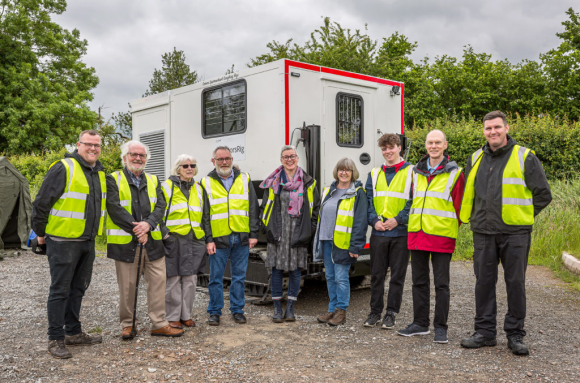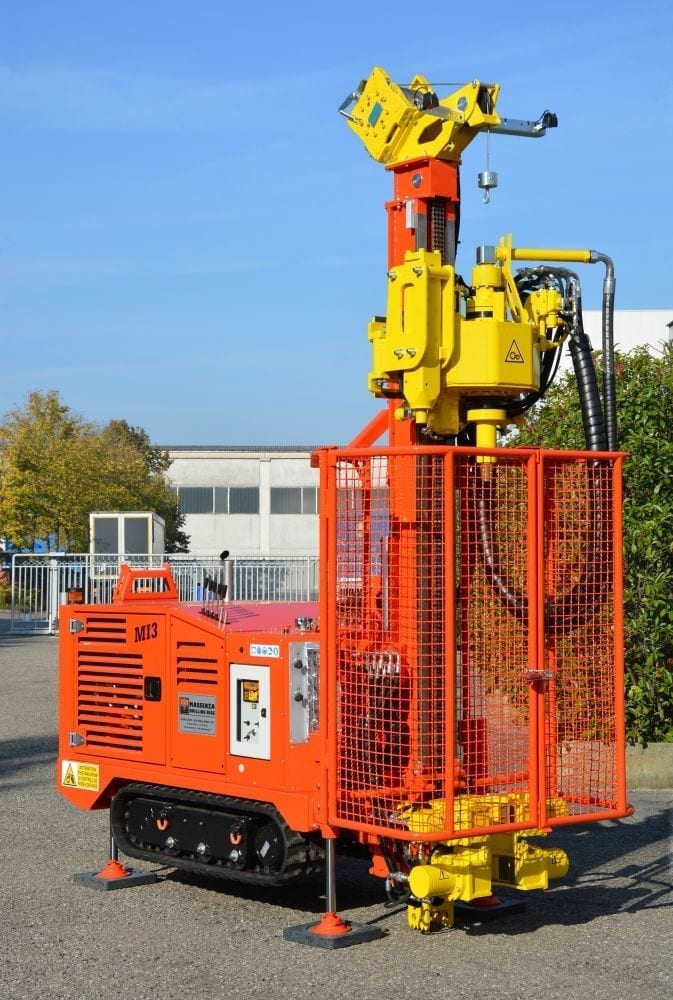Drilling for unexploded bombs in London
Igne uses Massenza MI3 drill rigs, supplied by RockBit, to conduct unexploded ordnance surveys in challenging spaces.
Igne mitigates explosive threats working largely in support of the construction industry to ensure unexploded ordnance (UXO) is not unexpectedly encountered during intrusive works.
Igne's UXO services for the construction industry
UXO services begin with a risk assessment to determine a project's likelihood of encountering an explosive threat. If the risk level is sufficiently high, a non-intrusive or intrusive survey follows to detect whether an explosive threat, such as an unexploded bomb from World War II is indeed buried on site.
Intrusive surveys for UXO
For intrusive surveys, rotary drilling can be used to create boreholes into which magnetometers are lowered in non-ferrous tubes to record the vertical depth of any magnetic anomaly, its horizontal distance from the probe and theoretical modelled mass.
The collected data enables the safe detection of explosive threats.
In 2019, Igne added a drill rig with a low masthead height to its extensive fleet because it was being increasingly contracted to conduct surveys in confined spaces for basement extensions in London and the South East of England, where the risk of encountering UXO can be very high.
An intrusive UXO survey rig for confined spaces
Igne contacted RockBit, the UK's supplier for Massenza drilling rigs, and was introduced to the MI3. Thanks to the exceptionally high level of service provided by RockBit and the diverse application possibilities of the MI3, the decision to purchase was made.
Igne's senior operations manager, Mark Smith, said of the purchase:
"The MI3 is absolutely ideal for basement extension jobs because of its ability in restricted-access sites. We made the decision to purchase it after a challenging job for a client. He had planning permission to extend beneath his London mansion and create a swimming pool. The area we were working in was tiny and, although it was in a basement, the swimming pool was still within the bomb penetration depth, so he needed full clearance. Because the MI3 can operate in really confined spaces such as this, it's a fantastic addition to our suite of rigs. The fact it's robust and can be used for other applications such as more normal bomb clearance and pile probing, which are services we also offer, means it was the perfect rig for us.
Why is there a risk of encountering UXO when excavating for basement extensions?
London was heavily bombed during the Second World War, but not all ordnance detonated. At the time the approach taken to the risk was sometimes to simply fix a building and leave an unexploded bomb where it was.
There are good records of where these bombs fell because even though they didn't explode, they damaged buildings and this damage was documented.
At Igne, our brilliant researchers use this historical data to help with the creation of threat assessments. But we also know that there are very likely to be buildings resting on top of UXO that are not recorded anywhere - this can be because of something called the J curve effect.
What is the unexploded ordnance (UXO) J curve effect?
There’s a phenomenon relating to air-dropped ordnance called the ‘J curve’ that constructors and ground workers should be aware of. This is where an air-dropped bomb released from a normal bombing altitude of around 4,000m to 5,000m on its curved trajectory can reach a terminal velocity of between 350-400 meters per second. This causes the bomb to enter the earth at an angle of approximately 15 degrees from the vertical, but its exact route is difficult to locate.
The bomb is being driven by its kinetic energy, and can, unless deflected, continue on its line of flight and can turn in an upwards curve towards the ground surface as it slows down and comes to rest.
The final location of the bomb is referred to as the offset and unexploded bombs have been found up to 15m from their point of entry. This upwards J curve is caused by the transfer of energy as the bomb travels through the ground. The nose of the bomb travels slower than the rear of the bomb due to the drag/friction of it passing through the ground. The rear of the bomb, having more energy due to less drag/friction is travelling much quicker causing the bomb to point back upwards.
Depending on the ground conditions, the bomb’s angle of impact and the J curve, unexploded bombs can - and have - come to rest beneath undamaged buildings.
When we survey using a rig like the MI3 we always include a buffer zone in addition to the risk zone to cover off on the J curve effect.
With an increase in basement works there's an increased need for the MI3 because it can be taken in to even a listed building without compromising the façade or the building's main structure.
Since taking delivery of the MI3 , Igne's explosive ordnance experts have utilised it on multiple projects including four in London and one in Hull. Most recently the MI3 has spent three and a half weeks on-site in Sheffield conducting intrusive surveys ahead of geothermal works.
If you have a small or confined space that needs surveying to discount the risk of UXO being present - contact Igne. We have the most extensive fleet of equipment, the highest qualified staff and the most experience of any company in our industry ... in other words, we're your safest pair of hands!
Igne mitigates explosive threats working largely in support of the construction industry to ensure unexploded ordnance (UXO) is not unexpectedly encountered during intrusive works.
UXO services begin with a risk assessment to determine a project's likelihood of encountering an explosive threat. If the risk level is sufficiently high, a non-intrusive or intrusive survey follows to detect whether an explosive threat, such as an unexploded bomb from World War II is indeed buried on site.
For intrusive surveys, rotary drilling is used to create boreholes into which magnetometers are lowered in non-ferrous tubes to record the vertical depth of any magnetic anomaly, its horizontal distance from the probe and theoretical modelled mass. The collected data enabling the safe detection of explosive threats.
In 2019, Igne decided to add a drill rig with a low masthead height to its fleet as it has been increasingly contracted to conduct surveys in confined spaces for basement extensions in London and the South East of England, where the risk of encountering UXO can be very high.
Igne contacted RockBit, the UK's supplier for Massenza drilling rigs, and was introduced to the MI3. Thanks to the exceptionally high level of service provided by RockBit and the diverse application possibilities of the MI3, the decision to purchase was made.
Igne's senior operations manager, Mark Smith, said of the purchase: "The MI3 is absolutely ideal for basement extension jobs because of its ability in restricted-access sites. We made the decision to purchase it after a challenging job for a client. He had planning permission to extend beneath his London mansion and create a swimming pool. The area we were working in was tiny and, although it was in a basement, the swimming pool was still within the bomb penetration depth, so he needed full clearance. Because the MI3 can operate in really confined spaces such as this, it's a fantastic addition to our suite of rigs. The fact it's robust and can be used for other applications such as more normal bomb clearance and pile probing, which are services we also offer, means it was the perfect rig for us.
"London was heavily bombed during the Second World War, but not all ordnance detonated. At the time the approach taken to the risk was sometimes to simply fix a building and leave an unexploded bomb where it was. There are good records of where these bombs fell because even though they didn't explode, they damaged buildings and this damage was documented. We use this historical data to help us with our threat assessments. But we also know that there are buildings resting on top of ordnance that's not recorded anywhere - this can be because of something called the J curve effect. As bombs fall and hit the ground, they start to decelerate nose-first. As the nose is moving slower than the tail of the bomb this introduces a tipping effect in terms of the trajectory of the ordnance. Eventually, the nose slows sufficiently that a bomb can level out - but it can also mean that the bomb actually comes back up again in a J shaped curve, driven by the tail. Bombs can travel underground for between 5 and 10m meaning they can come to rest underneath otherwise unaffected buildings. When we survey using a rig like the MI3 we always include a buffer zone in addition to the risk zone to cover off on the J curve effect.
"With an increase in basement works there's an increased need for the MI3 because it can be taken in to even a listed building without compromising the façade or the building's main structure."
Since taking delivery of the MI3 late last year, Igne's explosive ordnance experts have utilised it on multiple projects including four in London and one in Hull. Most recently the MI3 has spent three and a half weeks on-site in Sheffield conducting intrusive surveys ahead of geothermal works.
Other articles of interest

Igne launch
Igne launch sees transformative merger of six leading companies to reshape pre-construction services in the infrastructure, energy and water sectors.

Cone penetration testing with Connor’s Rig
One of the reasons behind the UK land team’s decision to invest in Connor's Rig from Geomil earlier this year was to advance Igne's (formerly SafeLane) cone penetration testing (CPT) capability...


